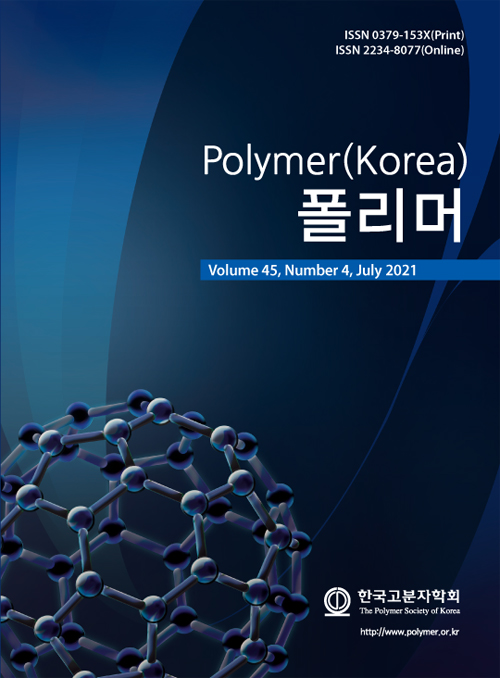- Characteristics of Ball Milled CNT-Graphene Hybrid Nanoparticle and the Sheet Resistivity of PET Film Coated with Nanoparticles
Dept. of Chemical Engineering, Kumoh National Institute of Technology, 1 Yangho-dong, Gumi 39177, Korea
*Applied Carbon nano, No.104, Pohang Technopark 4th Venture Bldg, 364 Jigok-ro, Nam-gu, Pohang, Gyeongbuk 37668, Korea
**Industry-Academic Cooperation Foundation, Kumoh National Institute of Technology, 1 Yangho-dong, Gumi 39177, Korea- 볼밀링으로 제조된 CNT-Graphene 하이브리드 나노 입자의 특성 및 나노 입자가 코팅된 PET 필름의 표면저항
금오공과대학교 화학공학과, *어플라이드 카본나노, **금오공과대학교 산학협력단
Reproduction, stored in a retrieval system, or transmitted in any form of any part of this publication is permitted only by written permission from the Polymer Society of Korea.
In this study, as a coating agent for a conductive film, CNT-graphene hybrid nanoparticle, which is a composite of carbon nanotube (CNT) and graphene, was prepared according to the content ratio of the ball and nanoparticle and the milling time. The optimum average particle size of the CNT-graphene nanoparticle was obtained when the CNT and graphene content ratio was 1:1, the ball and nanoparticle content ratio was 15:1, and the milling time was 3 to 5 hours. When only graphene was used, the average particle size in the dispersion solution was 0.5 to 1.7 µm, and the surface resistivity of the conductive film was 109-1010 Ω/sq. The average particle size of the dispersion solution using the CNT-graphene hybrid nanoparticle was 300-400 nm, and the surface resistivity of the conductive film was 104 Ω/sq. The surface resistivity of the conductive film was increased to 105-106 Ω/sq for 200 nm of hybrid nanoparticle.
연구에서는 전도성 필름용 코팅제로서 탄소나노튜브(carbon nanotube, CNT)와 그래핀(graphene)을 하이브리드화한 CNT-그래핀 하이브리드 나노입자를 ball과 나노입자의 함량비와 밀링 시간에 따라 제조하였고 이를 용매에 분산 및 필름에 코팅한 후 코팅층의 특성을 분석하였다. CNT와 그래핀의 함량비를 1:1로 하고 ball과 나노입자의 함량비를 15:1로 하며 밀링 시간은 3-5시간 진행하였을 때 CNT-그래핀 하이브리드 나노입자의 최적의 평균입자크기가 얻어졌다. 그래핀만 사용한 경우 분산 용액 내의 평균입자크기는 0.5-1.7 mm이고 전도성 필름을 제조한 후의 표면저항 값은 109-1010 Ω/sq이 얻어졌다. CNT-그래핀 하이브리드 나노입자를 이용한 분산 용액의 평균입자크기는 300-400 nm이고 전도성 필름을 제조한 후의 표면저항 값은 104 Ω/sq이었으며, 평균입자크기가 200 nm인 경우 105-106 Ω/sq가 얻어졌다.
Keywords: carbon nanotubes, graphene, hybrid nanoparticle, conductive film, sheet resistivity.
- Polymer(Korea) 폴리머
- Frequency : Bimonthly(odd)
ISSN 0379-153X(Print)
ISSN 2234-8077(Online)
Abbr. Polym. Korea - 2023 Impact Factor : 0.4
- Indexed in SCIE
 This Article
This Article
-
2021; 45(4): 533-540
Published online Jul 25, 2021
- 10.7317/pk.2021.45.4.533
- Received on Feb 9, 2021
- Revised on Mar 11, 2021
- Accepted on Mar 16, 2021
 Correspondence to
Correspondence to
- Kwan Han Yoon
-
Dept. of Chemical Engineering, Kumoh National Institute of Technology, 1 Yangho-dong, Gumi 39177, Korea
- E-mail: khyoon@kumoh.ac.kr









 Copyright(c) The Polymer Society of Korea. All right reserved.
Copyright(c) The Polymer Society of Korea. All right reserved.